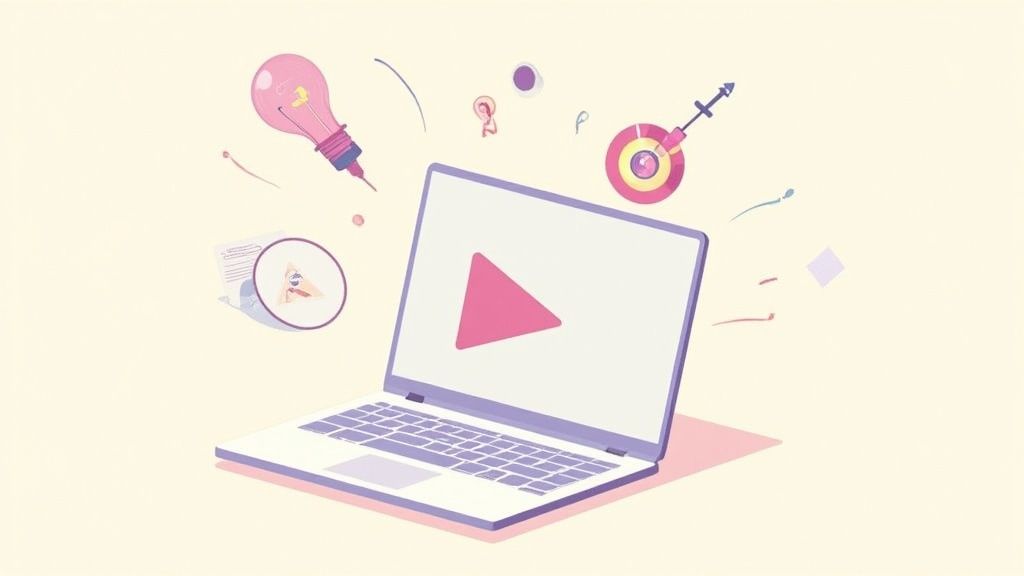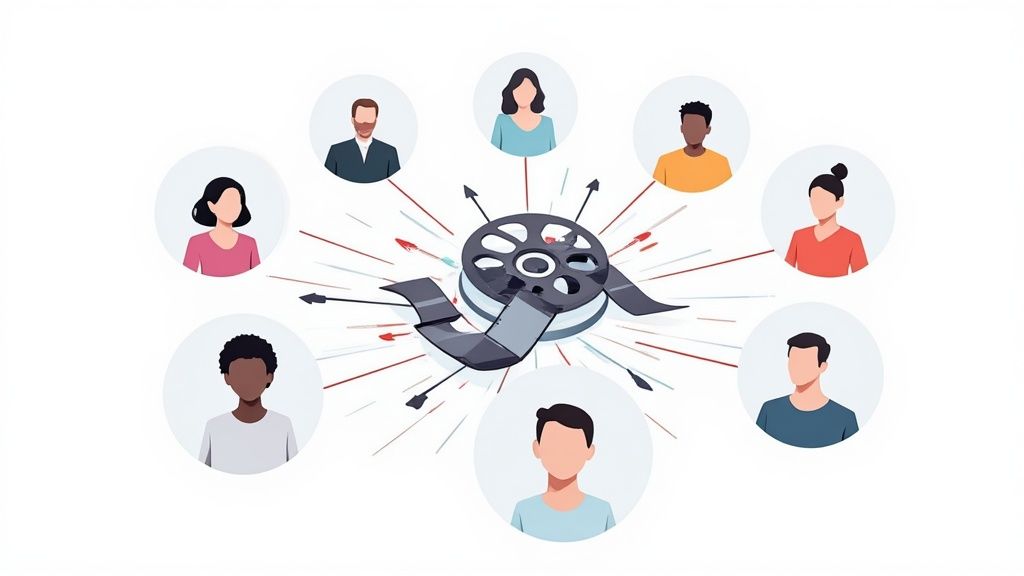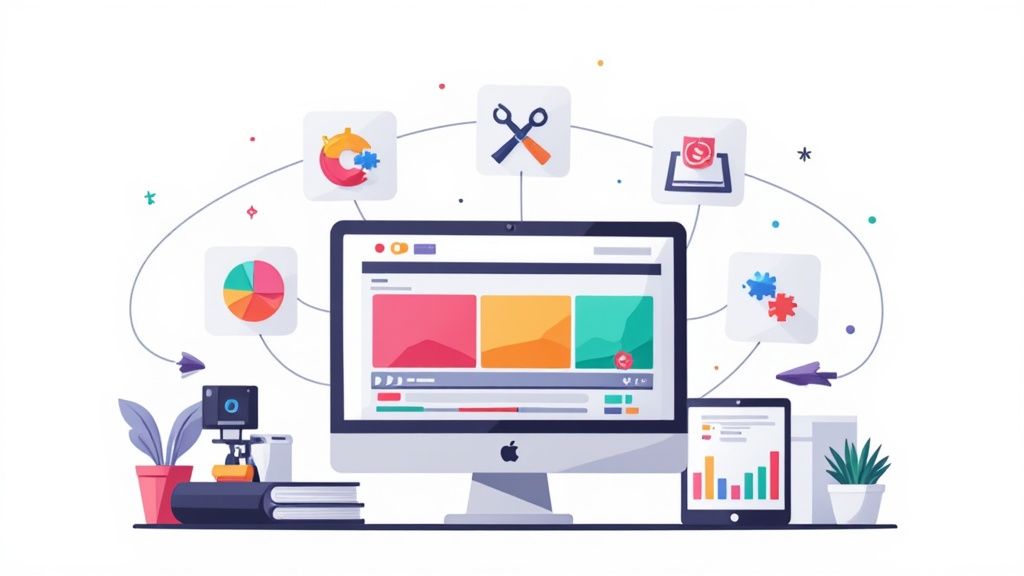29 Major Types Of Marketing Videos For Promoting Your Business



Regarding video content creation, figuring out where to start can feel overwhelming. There’s pressure to get it right, which often leads to overthinking. With so many styles and options, it’s easy to get stuck trying to pick the perfect type of marketing video for your business. This blog will help you do just that. Beyond this introductory guide to the types of marketing videos, you’ll also find helpful insights on how to use them effectively to enhance your video content creation projects. Instead of getting caught up in the details, it’s best first to understand the various types of marketing videos, how they differ and how to use each to achieve your goals.
What is a Marketing Video?

A marketing video is a strategic tool businesses use to:
- Communicate a brand's message
- Promote products or services
- Build customer relationships through video content
It is part of a broader video marketing approach that leverages visuals to engage and educate audiences. These videos can serve various purposes, from directly showcasing a product to telling stories that indirectly raise brand awareness or foster emotional connections with viewers.
The Goals and Benefits of Video Marketing
Creating a marketing video is aligned with a company's goals:
- Whether to drive sales
- Boost brand visibility
- Increase customer engagement
Once created, these videos are distributed across platforms to reach the target audience effectively, such as websites, social media, or email campaigns. Video marketing is data-driven businesses. You must track metrics to measure their success and adjust future strategies accordingly, such as:
- Views
- Shares
- Watch times
- Conversion rates
The Rise of Video Marketing in the Digital Age
Video marketing has gained prominence, especially in the age of social media, where video content captures attention and encourages interaction much more effectively than static images or text. It often works in harmony with other marketing channels, yet its capacity to quickly and memorably convey information makes it particularly powerful in today’s digital environment.
Related Reading
- Video Marketing Trends
- Digital Video Marketing
- Brand Video Examples
- Types of Video Advertising
- Types of Video Content
- Video Marketing Production
- Brand Awareness Videos
Why Is Video Marketing Important?

Video marketing is crucial because it taps into consumer preference for video content. As a Statista survey highlights, pre-produced or live-streamed video is the most effective digital engagement tool globally. Over 81% of marketers already use pre-produced video, and another 13% plan to adopt it, showing its dominance in the marketing landscape. Live streaming is similarly popular, with 73% of marketers currently using it and 19% intending to do so. One primary reason for the video’s importance is its appeal to audiences.
Research shows that two-thirds of consumers prefer watching a video over reading to learn about products or services. This preference is reflected in the fact that video accounted for 53.7% of all internet traffic in the first half of 2021. By using video, marketers can effectively communicate their messages where their target audiences are most likely to engage, whether on social platforms, websites, or other video-friendly channels. Marketing through video yields five main benefits.
1. Video Marketing Effectiveness
Ninety-seven percent of surveyed marketers observed that video helps customers better understand their products. A close-up, for example, can spotlight a product more effectively than even the most descriptive copy. After watching a video, audiences retain 95% of the message but only 10% after reading the text.
2. Emotional Connection
Videos, particularly promotional ones, are compelling because they tap into human emotions. People often base their decisions on emotions, and videos that create an emotional connection can be more persuasive and memorable. This emotional appeal is crucial in all promotional videos, whether on:
- Corporate videos
- Product videos
- Client testimonials
- Social media videos
3. Increased Conversion Rates
Approximately half of all consumers hunt for and watch product videos before making a purchase decision. Ninety percent of consumers surveyed find demo videos helpful, and 85% are likely to purchase after watching demos.
4. Elevated SEO Ranking
Seventy percent of the top 100 Google search-result listings display video content. Also, because search-engine bots can transcribe video audio before delivering it to the relevant audience, adding video to marketing campaigns can make them more discoverable. Plus, you can add links to videos to bolster traffic further.
5. Higher Email ClickThrough and Open Rates
Studies show that adding the word “video” to the email subject can raise open rates by 19%, clickthrough rates by 65%, and reduce unsubscribes by 26%.
29 Major Types Of Marketing Videos For Businesses
1. Brand Videos: Build Trust with Potential Customers
Brand videos introduce your company to potential customers. These short marketing videos, about 90 seconds long, provide a:
- Snapshot of your mission
- Values
- Overall company culture
Rather than focusing heavily on specific products or services, brand videos aim to create an emotional connection with the audience, fostering a sense of trust and familiarity.
2. Explainer Videos: Help Customers Understand Your Business
Explainer videos are designed to introduce and explain the functionality of your products or services. With 91% of people reporting they’ve watched an explainer video to learn about a product, this format is incredibly effective for top-of-funnel marketing.
They’re ideal for educating viewers while keeping them entertained, making them more likely to explore further. These videos help potential customers quickly understand how your product solves their problems. They are:
- Typically short
- Engaging
- Straightforward
3. Product Demos: Show How Your Product Works
Product demos offer a more in-depth look at how your product or software works, highlighting features and benefits to potential buyers. These videos can vary in:
- Length, from short demos that cover vital features in just a few minutes
- More extended, more detailed overviews that may last up to an hour
Demos are particularly useful for potential customers who are further down the sales funnel and want to see precisely how a product can meet their needs before making a purchase decision.
4. Animated Videos: Simplify Complex Topics
For businesses dealing with complex concepts or ideas, animated videos are a powerful way to simplify and convey challenging information. Animation adds a visual element that can break down intricate topics into easily digestible content, making it perfect for educational purposes or explaining complicated services. Like explainer videos, these are often short but can be packed with information in an engaging, creative way.
5. How-To Videos: Provide Helpful Tips for Using Your Products
How-to videos or tutorials provide step-by-step instructions on accomplishing specific tasks using your product or service. These videos cater to current customers who want to get the most out of their purchase and potential customers researching solutions to their problems.
Depending on the complexity of the task, how-to videos can be either short or long, but keeping them under 20 minutes ensures they remain accessible and engaging.
6. Video Podcasts: Enhance Your Audience’s Viewing Experience
Video podcasts add a visual component to discussions or interviews, providing a richer experience than audio-only podcasts. Often with the flexibility to host different guests and experts over time, this format works well for:
- Thought leadership
- Interviews
- Deep dives into specific topics
Video podcasts can build an extensive content library for your audience, encouraging long-term engagement with your brand.
7. Case Studies: Highlight Real-Life Applications of Your Business
Case study videos feature real-life customer stories, focusing on how your product or service helped them overcome a challenge. By showcasing relatable problems and offering your solution as the answer, these videos are highly effective in the consideration stage of the customer journey.
Potential customers see these stories as proof of the effectiveness of your offerings, helping to build credibility and trust.
8. Webinars: Share Knowledge to Generate Leads
Webinars are virtual events where speakers discuss a specific topic, often live with audience interaction through tools like Q&A or polls. They’re handy for generating leads by offering educational content in exchange for registration details. Post-event webinars can continue to provide value by:
- Being shared on-demand
- Extending their shelf life
- Increasing audience reach
9. Online Conferences: Repurpose Educational Content for Marketing
Like webinars, online conferences are virtual events on a larger scale. They usually feature multiple presenters and span several sessions. They mimic in-person conferences but are held online, making them more accessible to a broader audience. Live participation can boost engagement, while recorded content can be repurposed for further marketing initiatives after the event concludes.
10. Outreach Videos: Personalize Your Sales Pitches
Sales outreach videos are highly personalized and focus on introducing your product or service to a specific prospect. Unlike explainer videos or demos, outreach videos are tailored to the individual viewer, often including a customized introduction or direct address. This personalization helps build a connection and can significantly improve the effectiveness of outbound marketing efforts.
11. Social Media Videos: Engage Your Audience on Every Platform
Social media videos are optimized for platforms like:
These videos are typically under 90 seconds and formatted for mobile viewing where the audience’s attention spans are shorter. Videos like this are versatile tools for engaging existing followers and attracting new audiences. They can vary from:
- Promotional content
- Behind-the-scenes footages
- Interviews
- Tips
12. Video Ads: Target Potential Customers Effectively
Video ads are sponsored content on platforms like:
- YouTube
- LinkedIn platforms
These ads are targeted and ensure they reach the most relevant audience based on the following:
- Demographics
- Interests
- Behaviors
Video ads typically include a call-to-action (CTA) to drive conversions, whether:
- Signing up for a newsletter
- Purchasing a product
- Visiting a website
13. Training Videos: Help Your Staff Improve Performance
Instructional videos explain new product features in addition to the basics. The content arms sales and customer service teams with the information needed to help potential customers make purchase decisions and learn how to use the product.
14. Demonstration Videos: Show How Your Product Works
Providing a video of how something works can be an effective way to sell customers on your product. Demonstration videos are ideal for showing your viewers:
- The effectiveness of specific products
- Their ease of use
- Ways the product can improve their lives
They provide an easy-to-understand visual presentation that can guide viewers through a product or service and discuss its specifications.
15. Consideration Video: Deepen Relationships with Potential Customers
Consideration videos often deepen the relationship between a brand and its potential customers and inspire interest. They are ideal for heated marketplaces and brands looking to cultivate a customer connection based on something other than discounts. Typically, the content demonstrates a brand’s expertise in a particular field, growing your subscriber base on YouTube and followers on different channels.
16. Conversion Video: Close the Sale
Conversion video is usually placed at the end of the marketing funnel. The most significant metric of this video type is sales, followed closely by the clickthrough rate. For example, viewers clicking but not buying might indicate a disconnect between your marketing efforts and the product.
17. Unboxing Videos: Satisfy Customer Curiosity
Unboxing videos show people opening packages or boxes of items they buy. Many people watch these videos for their unbiased view of the product. Instead of reading an opinion in a review, they can watch:
- The delivery of one product
- Learn about its delivery experience
- See the quality of its packaging
- Determine whether it looks the same as in advertisements
You can use unboxing videos in your marketing strategy to bring attention to your products and help consumers make purchasing decisions.
18. 360-Degree Videos: Provide Interactive Experiences
360-degree videos allow your consumers to see content from every angle. They can take consumers on a virtual tour of a store or facility, giving customers an inside look that might encourage them to purchase from the brand you promote.
19. Comedy Videos: Entertain Your Audience
Comedy videos can be handy when attempting to entertain and grab customers' attention. These videos focus on making viewers laugh, which can be helpful in marketing by associating positive and fun attitudes with a product or brand. Comedy videos boost your website traffic, which increases the chances of customers engaging with content about your products and services.
20. Tag or Challenge Videos: Engage Your Audience to Create Content
Tag or challenge videos encourage your viewers to create videos responding to an original post. Brands and influencers often use these to engage their audiences and advertise products. For example, a brand might release a new product and post a video inviting customers to post their videos using it.
21. DIY Videos: Showcase Creative Uses for Your Products
DIY videos showcase a business’s creative side, offering customers insights into innovative uses of products or creative applications. These marketing videos are handy for brands that provide products that customers can use in:
- Various projects
- Fostering community
- Engagement through shared creativity
22. Company Culture Video: Humanize Your Brand
Company culture videos highlight the human side of your brand on your YouTube channel or other streaming platforms. They should show your audience what work life is like at your company, amplifying the people and initiatives that make your company great.
Traditional culture videos often feature a few in-person interviews with staff members, mixed with some b-roll of people working and having fun in the office or at an offsite. But why not have fun with it and try something a little different? For example, you could have your team record themselves singing a popular song over Zoom or use puppets as Dropbox did.
23. Interviews or Q&A Video: Answer Audience Questions
Interviews or Q&As are videos that answer your audience’s most pressing questions and are part of a broader video strategy for your campaign. You could sit down with a thought leader, customer, or team member for your video chat or produce a solo video where a team member answers questions that people have submitted beforehand.
You can also record your interview in advance or conduct it live and publish the recording on your social media channels or videos. Interview videos are a great way to help your audience feel seen and heard. They also work as great educational content that can boost the impact of your social media marketing campaigns. Aligning your company with a notable thought leader or personality can build brand awareness and authority.
24. Personalized Video: Make Customers Feel Special
Did you know that 80% of online shoppers are more likely to buy from a company that offers a personalized experience, which includes personal videos? Personalized customized videos for your customers show that you genuinely care about them and their success.
25. Video Series: Create a Long-Term Engagement Strategy
As powerful as videos are, generating tons of views immediately is challenging. In most cases, you’ll need to release multiple videos before seeing results. By planning a regular series of videos, similar to drip email marketing campaigns, around a specific topic relevant to your prospective customers, you can gradually build up and nurture an audience while increasing brand awareness.
26. Paid Ads: Get Your Videos Seen By More People
So far, the videos we’ve discussed are primarily used as part of an inbound strategy, where people who are already interested in a topic view the video to learn more. Videos can also be vital to an outbound campaign executed through paid advertising.
Video ads are played:
- Before (pre-roll)
- During (mid-roll)
- After (post-roll)
On YouTube, they’ll either be longer adverts that are skippable or shorter and non-skippable. Either way, it’s essential to achieve these before the advert ends or they click the skip button:
- Lead with your hook
- Grabbing the viewers’ attention
- Getting your key message across before
27. Influencer Videos: Leverage Trusted Authorities
Marketers have long understood the power of influencers, whether a professional dentist in a white coat promoting a particular brand of toothpaste or a celebrity telling you about their favorite cookware. If you’re going to rely on an influencer in your video marketing, you don’t necessarily need a Hollywood actor.
Look for someone your target audience respects or admires as an authority. It allows you to borrow their credibility and use it to market your product or service.
28. Onboarding Videos: Welcome New Customers
Onboarding videos are similar to how-to videos but more conceptual. While a how-to might only cover the required steps, an onboarding video will also illustrate how using the product will improve the customer’s daily life. When your hard work pays off, and someone signs up for a free account or a trial period, your marketing must work hard to convert that lead into a customer.
Video content can help people get started on the right foot. Your onboarding video doesn’t need to be complicated or expensive to produce. It should deliver clear and concise information on best use of your tool or product.
29. Blog-to-Video: Repurpose Existing Content
Turning a blog post into a video is one of the best types of video marketing because it repurposes existing intellectual content and thought leadership.
The Basics Of Video Content Creation For Marketing

Creating video content, commonly called video production, is a multi-stage process where you plan, record, and edit video. It’s akin to filmmaking, but the images are recorded digitally instead of on traditional film stock. Just like on movie sets, marketing video production can be broken down into three main stages:
- Pre-production
- Production
- Post-production
Pre-production
The goal during pre-production is planning and preparation. It sets the foundation for the entire video project, ensuring clarity and direction before actual filming begins. This stage involves:
- Defining the video’s objectives
- Crafting a script
- Storyboarding
- Selecting a suitable location
- Organizing resources
Production
Production is the actual filming phase. The goal is to capture high-quality visuals and audio based on the pre-production plan. Ensuring the right environment and following the storyboard is crucial for a successful shoot. Activities include:
- Setting up cameras
- Lighting
- Directing actors or subjects
- Recording the footage
Post-production
Post-production focuses on refining the captured footage. The goal is to create a cohesive and engaging video. It’s where the raw footage transforms into a polished final product. This stage involves:
- Editing clips
- Adding special effects
- Integrating music or sound effects
- Color correction
- Finalizing the video for distribution
Like the range of written assets you can create using a content workflow, there are plenty of reasons to create video content. Statista revealed in its Q2 2023 statistics for weekly content consumption by video type. While music videos, comedy clips, viral memes, and sports highlights attract considerable attention, there are plenty of other formats brands can use to capture user attention and interest. The growth of video apps and video-on-demand platforms has boosted the demand for diverse types of videos.
How To Plan Video Content For Marketing
.avif)
Know Your Audience for Better Video Content
Define your target audience before creating your video. You need to understand your audience to reach your customers and understand their true wants and needs. Research your audience. Study their interests. It will help you create content that will interest and engage your customers.
Draw a detailed portrait of your target audience, including:
- Age
- Gender
- Marital status
- Employment
- Additional interests
Choose the Right Topic
Choose a relevant video topic. It should appeal to your target audience and support your marketing strategy. Determine what information you want to convey. Decide what story you want to tell or what problem you want to solve in your video.
Write a Script
A script is a blueprint for your video that describes:
- The sequence of events
- Dialogues
- Visuals
It helps you organize your thoughts and ensures that your footage develops logically. Write your script in advance, noting the key points and main issues you want to include.
Define a Video Format
Various footage formats attract different kinds of attention. Choose the one that best suits your topic and how you communicate with your target audience. It can be:
- Informative footage
- Review
- Blog
- Viral video
Plan the Shoot and Edit
To prepare for the shoot, start by determining:
- The necessary materials
- Planning the location
- Equipment
- Lighting
- Specific attributes you require
Consider the post-production phase and the video editing apps, tools, or technologies you will utilize to enhance the final product.
The Moonb Advantage: Why Choose Us
Moonb is a video marketing agency offering unlimited video editing subscriptions. We offer seamless project management integration via:
- Trello
- Slack
- MS Teams
We also have weekly strategy calls and a contract-free, full-service production approach. Moonb is a superior alternative to:
- Traditional video agencies
- Freelancers
- In-house production teams
Our flexible, subscription-based model, combined with our expertise in creating compelling video content, positions us as the ideal partner for companies looking to elevate their marketing and educational initiatives through the power of video. Start a 3-day free trial to take your content to the next level.
9 Tips for Promoting Engagement and Success
.avif)
1. Keep it Short and Captivating
Attention spans are short; studies show that 20% of viewers click away from a video within the first 10 seconds. To retain viewers, ensure your videos are concise and directly address the core message. The quicker you engage, the better your chances of holding attention throughout the video. Start with a:
- Compelling hook
- Ask questions
- Use teasers to spark curiosity
2. Refine Your Storytelling
Consumers often shy away from hard-sell advertising. Instead, focus on storytelling that revolves around your value proposition. Use video to evoke emotion and connect with your audience’s needs or desires. A clear and strategic call-to-action (CTA) at the end and a tracked URL are essential for driving conversions without feeling overly promotional. Crafting an engaging narrative helps differentiate your content from standard ads.
3. Create Educational Content
Videos are highly effective for educating audiences, with 65% of people being visual learners. Use this to your advantage to provide valuable insights by producing:
- Instructional videos
- Product demos
- Hosting webinars
Educational content builds trust and positions your brand as a thought leader, helping to nurture leads.
4. Optimize for Mute Viewers With Subtitles
Since 93% of mobile viewers watch videos on mute, subtitles are vital for keeping them engaged. A study found that 80% of people are likelier to watch a full video when subtitles are available. Automate subtitle creation using tools like Cloudinary’s AI-powered transcription to save time and ensure accessibility for your entire audience.
5. Tag Videos for Organization and SEO
Tagging your videos helps with both internal organization and public visibility. Automate tagging tools to categorize content efficiently, making it easier to reuse across social media and campaigns. Tag your videos with relevant keywords and titles for SEO purposes, host them on your domain, and create video sitemaps to ensure better search engine indexing.
6. Accelerate Page Loads
Slow page load times can deter viewers, especially on mobile devices. Videos consume significant bandwidth, so optimizing video quality and reducing the file size by adjusting codecs is essential. It ensures your video loads quickly without sacrificing quality.
7. Leverage User-Generated Content (UGC)
User-generated content (UGC), such as customer reviews or videos, adds authenticity to your campaigns. Research shows that consumers trust UGC more than branded content, making it a powerful tool for building credibility. Encourage your audience to share their own videos and highlight their experiences with your products or services.
8. Inject Humor
Humor can make your videos more memorable and shareable. It helps brands stand out by adding a lighthearted, entertaining touch to marketing messages. If done correctly, humor can improve brand perception and foster stronger emotional connections with your audience.
9. Track Performance Using Analytics
Tracking the right metrics is crucial to refining your strategy. Go beyond view counts and monitor engagement data to specific sections, such as when viewers:
- Pause
- Skip
- Re-watch
Google Analytics and tools like Cloudinary video player provide detailed insights into viewer behavior, helping you optimize your content for future campaigns.
Related Reading
- Video Production
- Video Production Cost
- Video for Lead Generation
- Best Practices for Video Marketing
- Corporate Video Production
- Freelance Animator
- Video Marketing Checklist
- How Much Does Video Editing Cost
- How to Hire a Video Editor
- Video Marketing ROI
- Hire Video Production Company
- Video Production Trends
6 Types Of Video Ads You Can Run

1. Skippable In-Stream Ads: The Viewer-Friendly Option
Skippable in-stream ads, or TrueView ads, appear before, during, or after other videos on platforms like YouTube. Viewers can skip these ads after five seconds, making them a more viewer-friendly option.
The advantage of skippable ads is that advertisers only pay when viewers choose to watch the ad for at least 30 seconds or interact with it. This format allows for longer storytelling and can effectively engage audiences who are genuinely interested in the content.
2. Non-Skippable In-Stream Ads: The Must-See Ad
Non-skippable in-stream ads play before, during, or after videos and must be watched in their entirety. These ads typically last between 15 and 20 seconds and are effective for ensuring that your entire message is delivered without interruption.
While they guarantee that viewers will see the ad, their mandatory nature can sometimes lead to frustration. Non-skippable ads are often used for brand awareness campaigns where complete message retention is critical.
3. In-Feed Video Ads: The Cost-Effective Option
In-feed video ads appear in search results and on the YouTube homepage, resembling regular video listings. These ads include a thumbnail and description, enticing viewers to click and watch the full video. Advertisers are charged only when users click on the ad, making this format cost-effective for driving traffic to specific content.
In-feed video ads are excellent for increasing brand visibility and promoting products that require more detailed explanations.
4. Bumper Ads: The Short and Sweet Video Ad
Bumper ads are short, non-skippable video ads that last up to six seconds. They are designed to deliver concise, memorable messages quickly and are typically placed before a viewer's selected video. Due to their brevity, bumper ads are particularly effective for reinforcing brand messages or promoting short-term campaigns. They work well with longer video campaigns to create a comprehensive marketing strategy.
5. Masthead Ads: The Feature Presentation of Video Ads
Masthead ads occupy prominent space at the top of the YouTube homepage and auto-play without sound for up to 30 seconds. These ads are designed for maximum exposure and are ideal for large-scale campaigns, such as product launches or major announcements.
Masthead ads can be either videos or images and typically require reservation due to their high visibility. They are charged on a cost-per-thousand-impressions (CPM) basis.
6. YouTube Shorts Ads: The Ad for the TikTok Generation
YouTube Shorts ads leverage the popularity of short-form video content on YouTube's platform. These ads can appear between Shorts videos and offer a unique way to engage with audiences who prefer quick, digestible content. Shorts ads allow brands to connect with younger audiences effectively as part of the growing trend toward short-form media consumption.
- Video Marketing Companies
- Video Editors for Hire
- Video Editing Companies
- Best Video Production Companies
- Video Animation Services
- Motion Graphics Studios
- Video Production Team
- Unlimited Video Design Services
- How to Choose a Video Production Company






